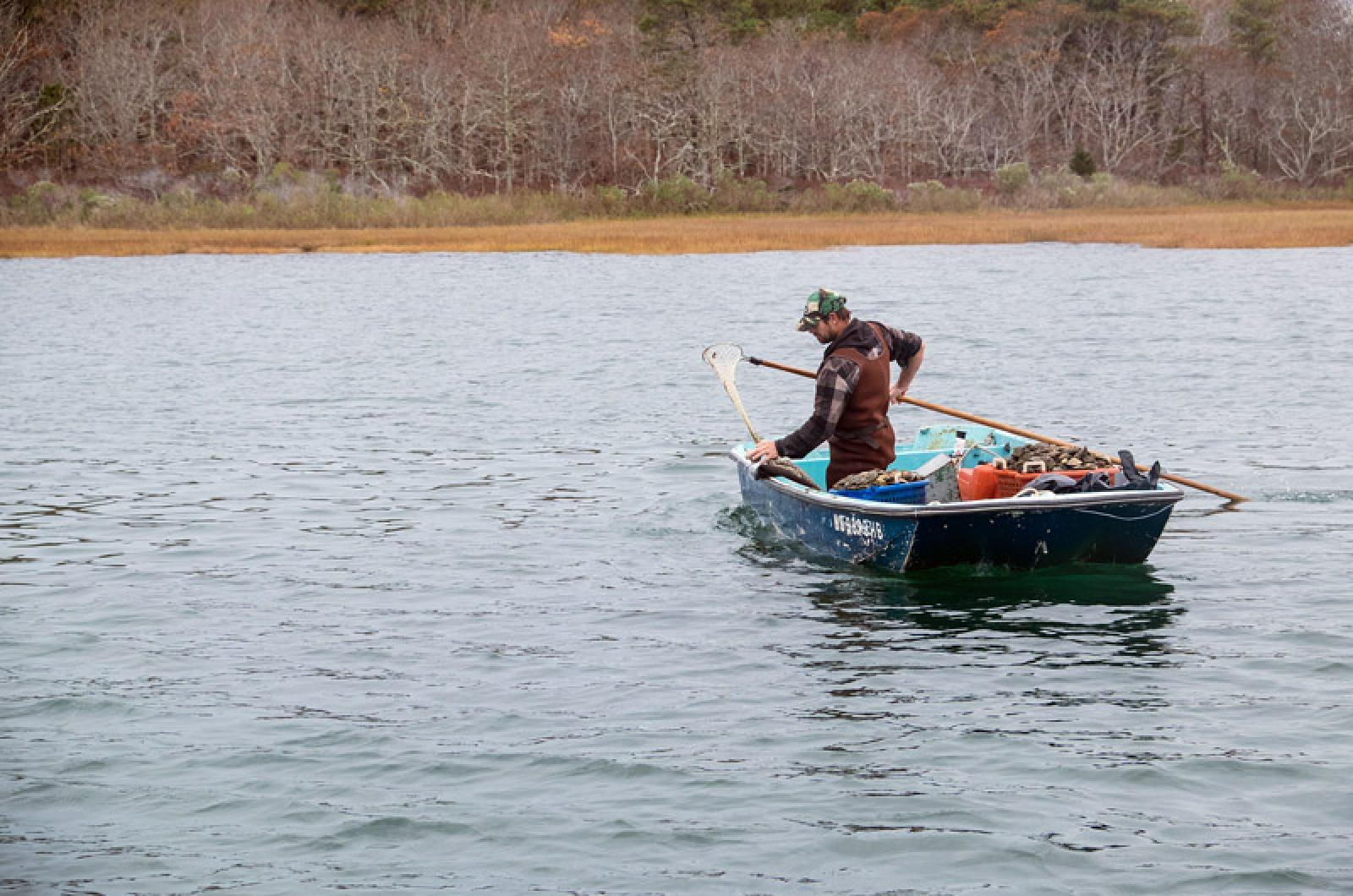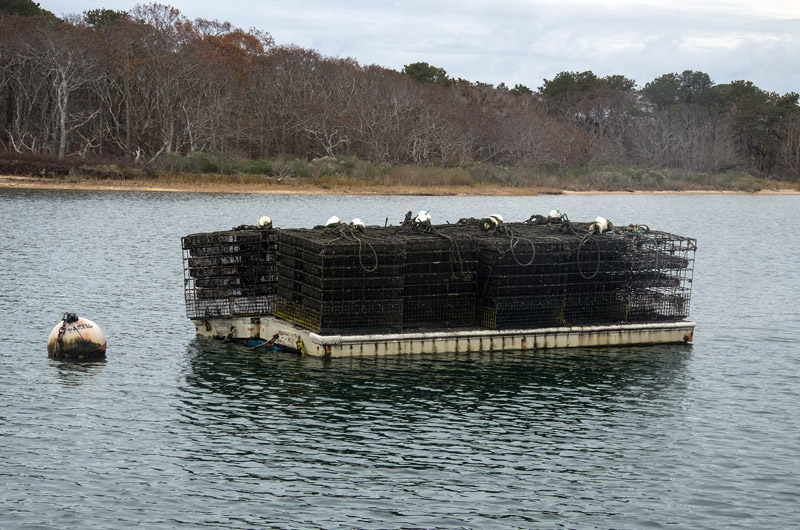The bottom of Sengekontacket Pond this week was covered with oysters and scallops, visible through about eight feet of water as light or dark splotches. The dark ones are older and covered with seaweed, barnacles and other organisms.
A few commercial fishermen quietly collected their daily load of scallops with long dip nets from their boats, a common sight on the coastal estuary, despite the loss of eelgrass and other organisms that has accompanied development in the watershed.
Peter Jackson grabbed a clam rake aboard an Edgartown shellfish department boat and reached over the side. A few seconds later, eight or ten full-grown oysters clattered onto the wooden culling board spanning the deck, each one a different size and shape, with jagged edges and cascading growth lines.
“Our objective is to grow them and put them out for people to get,” said Mr. Jackson, one of three deputy shellfish constables on the water this week. “We’re not trying to sell them, so we’re not making them perfect looking.”
A few moments later, the boat pulled up beside a white buoy in Major’s Cove, on the north end of the pond where large houses line the shore. After securing a rope, Mr. Jackson flipped the switch on a winch, and a huge cage emerged from the water, containing 12 flat, square bags made of stiff mesh material. Within each bag were about 250 young oysters, each one around two inches long.
The boat floated in a field of identical buoys, each one marking a cage with 12 bags. Altogether there were about 375,000 oysters growing below the surface.
The Major’s Cove oyster project began three years ago with funding from voters. Each year the shellfish department adds about half a million oysters to the farm and distributes the adults like Easter eggs along the bottom. The goal is mainly to get them out of the water, along with the nitrogen tied up in their bodies.
Shellfish play an integral role in the health of pond ecosystems, filtering water and creating habitat for other species. A single adult oyster might filter 50 gallons of water a day, removing phytoplankton and the nitrogen that fuels its growth.
An excess of nitrogen, mostly from septic tanks, fertilizer and runoff, fuels the growth of algae in coastal ponds, leading to a decline in pond health around the region. Sengekontacket — and Major’s Cove in particular — is among the most impaired ponds on the Vineyard.
The continued success of the Major’s Cove program will depend on large annual harvests. Anyone with a family shellfish permit in town may take out a half bushel of oysters a day. But that is unlikely to amount to a full harvest, especially in the secluded cove, where the shellfish department has struggled to attract family fishermen.
“We are a victim of our own success,” Edgartown shellfish constable Paul Bagnall said this week, surrounded by ropes, buoys and other equipment beside the shellfish department barn in Katama. “We have planted so many oysters in Sengekontacket that the family people can’t possibly take them all out.”
He plans to ask the town selectmen on Monday to approve a commercial oyster season in the pond this year, a first. He compared the product to wild-caught oysters, which fetch about 30 cents apiece at market.
Without the town’s aquaculture program, oysters in Sengekontacket would succumb to oyster drills and other predators that thrive in high-salinity water. Until now, oyster habitat on the Island has been limited mostly to the south shore ponds, which remain closed to the sea for much of the year and maintain a lower salinity.
“Essentially we are introducing a new species,” said Oak Bluffs shellfish constable David Grunden, who is heading up a nearly identical project on the Oak Bluffs side of the pond. “We don’t think it will take over, and at least think that the natural recruitment will be next to zero.”
So far the Edgartown shellfish officers haven’t seen any drills, which is a promising sign. Efforts by the Martha’s Vineyard Shellfish Group to set up experimental oyster beds in the Lagoon Pond on the Tisbury side have not been able to overcome the predators.
While serving a different purpose, the Major’s Cove project closely mimics the 12 commercial oyster farms in Katama Bay, which produced a total of 6,480 bushels last year. In the middle of the cove this week, a large raft carried stacks of empty mesh bags, drying in the sun to kill off the barnacles and other animals that attach to them.
Katama oysters get tumbled at certain points in their life to smooth out their edges and encourage a more cupped shape. But despite the more rugged appearance of Sengekontacket oysters, the amount of meat is about the same.
Jack Blake, a pioneer of oyster farming on Katama, designed the wooden upweller that now sits beside the shellfish barn, waiting for next year’s shipment of baby oysters from Maine. The upweller cost about $5,000, not including labor, and is unique to the pond, whose depth reaches only about 10 feet. Oak Bluffs has a similar upweller that is being stored near the Little Bridge.
Resembling grains of sand, the baby oysters are placed in mesh bins inside the upweller, where tidal currents keep them evenly distributed and well fed for a year. As they grow, they are moved to coarser and coarser mesh bins and then transferred to the bags.
“You’ve got to keep right on it because all of a sudden they will explode like popcorn,” Mr. Jackson said. They usually reach full size in a year, with the fastest growth in the summer.
Edgartown allows recreational oyster fishing from October through April. Pending approval by the selectmen on Monday, the commercial season would last through the winter.
“Sengekontacket is still going to need some work but the numbers are showing promise,” Mr. Bagnall said, noting that nitrogen increases in the pond appear to have stopped. If each full-sized oyster contains 0.3 grams of nitrogen, that would amount to a potential harvest of about 150 kilograms per year, or about 14 per cent of the reduction target as defined by the Massachusetts Estuaries Project.
But those numbers reflect only the amount of nitrogen in the shells and soft tissue. Much of the nitrogen ends up in feces, which get buried in the sediment. Decomposition can then convert some nitrate into nitrogen gas, which escapes to the atmosphere. Some experts believe that denitrification may account for more than 10 times the amount of nitrogen stored in the animals’ bodies. But the data is still lacking.
Measuring the oysters’ contribution to denitrification is expensive and challenging, said shellfish group director Rick Karney. “It’s outside the scope of our abilities,” he said. He added that high variability further complicates the data.
But data for the animals themselves are more standard. A study published by the Woods Hole Sea Grant Program in 2014 found that oysters on the Cape contained an average of 0.28 grams of nitrogen, slightly more than the average quahaug. Oysters cultivated on pond bottoms — as they are in Sengekontacket — had thicker shells and contained 0.32 grams of nitrogen, more than wild samples and ones that grew in floating cages.
Nitrogen removal may fluctuate according to predation, disease and weather, according to the study. And nitrogen levels in each animal depend largely on its size, along with the time of year and how it was grown. The study notes that shellfish tissues can “fatten” by as much as 98 per cent in the fall to prepare for the cold weather.
Edgartown and Oak Bluffs purchase their oyster seed from Muscongus Bay Aquaculture in Maine, which also supplies Katama Bay farmers. Those oysters are resistant to diseases such as Dermo, which oysters here can contract after five or six years. “As long as they don’t get Dermo, these could live for 20 years,” Mr. Jackson said, although the goal is to harvest them much sooner.
Around 2002, the Massachusetts Estuaries Project began assigning maximum daily nitrogen loads for coastal ponds in the state. But officially meeting those targets will require state-approved techniques. One goal of the Sengekontacket projects is to demonstrate with hard numbers that aquaculture can in fact remove nitrogen from the water.
Using the mesh bags, for example, allows for a more accurate count of oysters in the pond, since each bag contains about the same number. “Otherwise we could have done this a whole lot cheaper by augmenting the bottom with shell and using a remote-set larvae,” Mr. Grunden said. Each program cost about $50,000 to get off the ground.
Similar aquaculture projects are underway in Falmouth and Mashpee on the Cape, where eutrophication over the years has led to fish kills and the loss of pond habitat.
Aquaculture harvests in the Mashpee River since 2006 have ranged from 100,000 to 520,000 oysters per year, or up to five per cent of the estuary’s nitrogen reduction goals. Town shellfish constable Richard York told the Gazette this week that no fish kills have occurred in the estuary since the program began. “So it looks like the oysters are helping to hold the line,” he said.
Originally, the Edgartown and Oak Bluffs departments had considered running a joint program, but decided they would have better luck with funding if they asked the towns separately. In subsequent years, Edgartown voters have been generous, easily approving another $20,000 last year and the hiring of a new deputy shellfish officer this year to run the farm.
“If you keep it real then the voters are going to support the shellfishery,” Mr. Bagnall said, noting the project’s clear mission and its appeal to family fishermen. “I believe it’s one of the crown jewels of Edgartown — our shellfish industry and our harvest.”
Oak Bluffs cultivated a quarter million oysters this year, and plans to expand to a half million next year, with fishing in the pond allowed from November to April.
Mr. Grunden is also contemplating similar projects in the Lagoon and possibly Farm Pond, which is on track to have two eight-foot culverts installed to improve flushing and meet the MEP target. Funding for that project was approved at the town meeting in April. But in general, Mr. Grunden was reluctant to take on other major projects without increasing his staff.
Mr. Bagnall noted that aquaculture would not solve the Island’s nitrogen problem on its own. He cited Edgartown’s fertilizer regulations, approved last year, and other efforts around the Island as integral to the restoration process. But few of those solutions would actually remove nitrogen from the water, which makes aquaculture a key element.
In a worst-case scenario, if the program folds in five years, it will still have performed an ecological service, Mr. Bagnall said, noting the amount of nitrogen already removed through oysters.
“It’s hard to put a number on it, but it’s still a success for the pond,” he said.











Comments (3)
Comments
Comment policy »